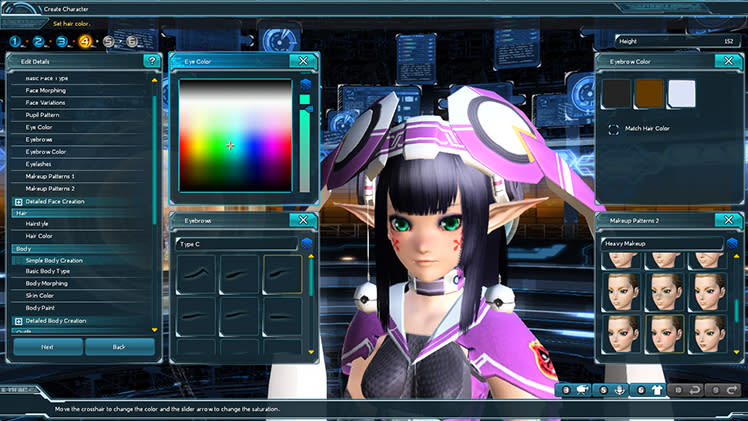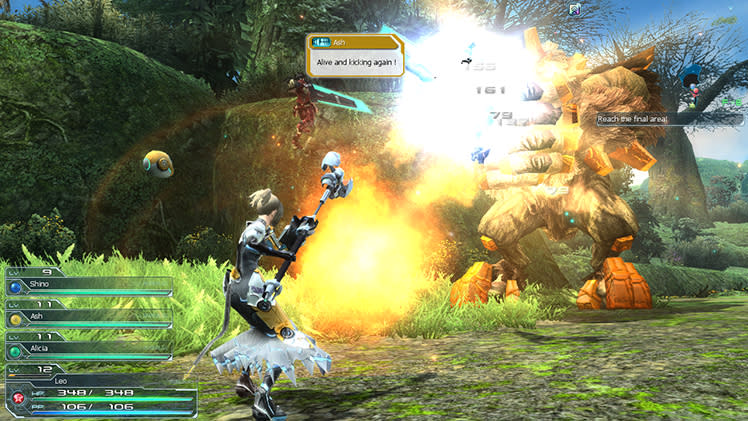What’s holding Phantasy Star Online 2 back from space-level greatness?
Sega’s purposely-tailored throwback to the original Dreamcast online RPG appears admirable, but may not gel with today’s demanding audience
Magic and plasma swords beat rock. Image credit: Sega
The countless space-themed missions I underwent as the pompadour-donning long range-focused Ranger bearing a planetary-sized girth proved a number of key things about the English version of Sega’s Phantasy Star Online 2.
One, it’s going back to basics with the massively multiplayer online role-playing game framework. And two: its character customisation screen allows for many esoteric creations thanks to its detailed settings. From anorexic Newmans (think Space Elves in the Phantasy Star universe) to Big Beautiful CASTs (the all-caps android race of any sci-fi story trope), no archetype is spared in PSO 2’s universe.
The old school apparel towards the Dreamcast prequel starts out with its straightforward narrative. Players start out as rookie cadets on this giant spaceship hub called the ARK doing space bounties and wildlife subduing. As they do so, they’re wrapped up in an impending intergalactic war that involves ancient space evildoers called the D-arks. While it’s pretty certain that these D-arks will have giant space demons in their army, we only got a sampling of their ferocity in the form of four-legged crawlers and a giant floating monstrosity that summons additional creepy-crawlies and what we assumed are pixelated dark energy plasma balls.
While players can further the story by doing missions listed on the Paradigm Matrix, they can opt to just farm for levels and wealth with the standard daily quests and Client Requests. While the usual “kill x things” quest types are present, at least some of them are given time limits so that players don’t faff about and attempt to find the most efficient manner to deal with multiple objectives. While this seems like Sega’s surefire way to keep the game back to basics, it does bode a long-term problem which we’ll get to.
Players can deal with these scenarios by starting out with one of the three classes: the melee-focused Hunters, the long-ranged Rangers, and the spellcasting Forces (with the fourth ninja-like class Bravers being an expansion addition). Stats vary between the classes; magic users have higher magic resistance, melee classes have higher hit points, and so forth.
However, players can access three of the main beginner classes and allocate points onto them. Picking a class at the start just adds additional skill tree options, thus the option to branch out and multi-class is there even if it’s recommended that beginners should focus on just one tree for maximum skills and effects.

From Gundam-lookalikes to space lolis, PSO 2′s character creation screen is knee-deep in depth and options. Image credit: Sega
Our fascination with guns in a sci-fi setting made us opt for the Ranger and his wily zone-heavy ways. With controller in hand (all automatically mapped upon plugging in, mind you), suddenly the game morphs into a shooter. We can use up-close third person view with a click of the left analog stick for an Uncharted venture complete with manual aiming.
Alternatively, we can usual normal distance third person view where we’re allowed to automatically lock on and switch targets. While it’s not necessary, especially for other classes that rely on close-ranged brutality and support, it’s a nice option for those who prefer their fights at a comfortable distance.
Regardless, the “action” in this action RPG comes in instance-sized doses so that combat reactions and commands flow better without any worry of server lag from overpopulation. Hordes of space monkeys and space chicks (of the grounded avian kind) swarm my oddly-dressed Ranger from all corners with rolling attacks and literal pecking orders. We had to maintain our distance as we unleashed piercing bullets, grenades and sniper bullets to keep the pack at bay.
The fighting is made all the more interesting with the Weapon Palette, where players can switch between three weapon and spell setups on the fly. For our Ranger, we alternated between a standard sniper rifle, a close-ranged gun blade, and a giant grenade launcher. It’s effortless to juggle foes at one moment using the alternate melee swipes and scatter shots of the gun blade, and then change back to using the grenade launcher’s area-of-effect for the group-scaled coup de grace.
While we didn’t get far enough on our beta preview of the English version, we do know that class upgrades will happen around the level 30 mark. Diligent players sticking to one class and fulfilling specific client orders can unlock the more powerful fighter, gunner and techtor classes.
Of course, the path between your early one-digit level to that golden number is made into more of a slog when you bring into the fact that all quests revolve around the extermination of enemies and the locating of the exit. Granted, these activities are made fun, but that’s the possible kicker of Sega’s throwback: the fear of alienating potential audiences who have yet to even remember what Phantasy Star was back in the late 90s and early 2000s.

The action and pyrotechnics satisfy on a core level, but is that enough for longevity? Image credit: Sega
Newer players will demand more from their MMOs from weapon customisation to elaborate quests in later World of Warcraft expansions. Older players who remember the Phantasy Star brand may not be open to the free-to-play aspect of PSO2. While the usual options of ludicrously decorating your player character with exclusive garbs is present, the other supplementary items that dish out double the experience points gain and rare item drop rate may come across as inappropriate for those not aware of how the model works. The old guard may even scoff at the idea of self-resurrection on the spot of death requiring real life cash.
But that’s the price of progress. By mixing in the old-school approach of an MMO while giving it a current payment model update, Sega may have landed in a possible Catch 22 situation. The game initially seems less varied to new players spoilt for MMO choice, while old players may be too stubborn to open up to their legacy franchise “reduced” to such a state. Barring that, the spectacle and fights in Phantasy Star Online 2 was decent enough to captivate our attention for long-term play. And it’s really fun to do this in a group when fighting against mobs and bosses like the ginormous Rockbear, where teamwork fighting and spellcasting is essential in surviving the odds.
And then there’s the Episode 2 content that introduces new areas and a new speed-based melee class. Southeast Asia distributors Asiasoft will need to deliver the whole shebang from Japan to at least attract potentially interested parties from the rest of the competition; all for the sake of keeping Sega’s star burning. Time will tell if the series will find new legs in the local market when it hits on May 29 for the English-speaking public.
Enthusiastic space explorers can try their hand on the weekend beta session from April 10 to 13; legit codes can be found here.
The post What’s holding Phantasy Star Online 2 back from space-level greatness? appeared first on e27.



